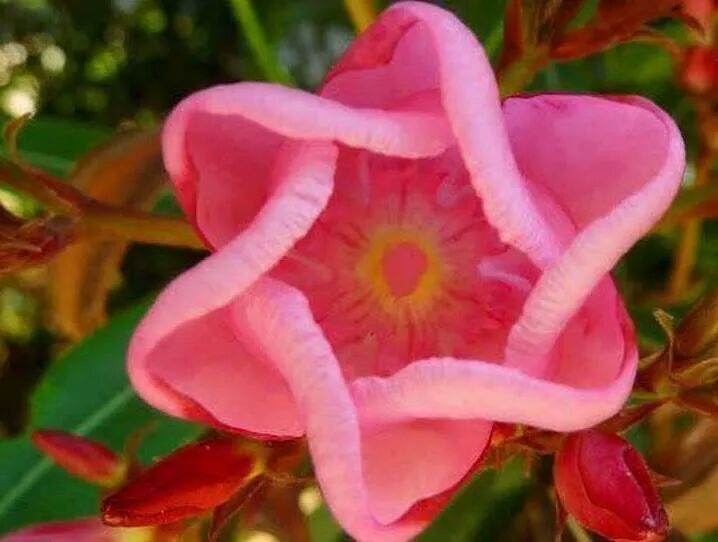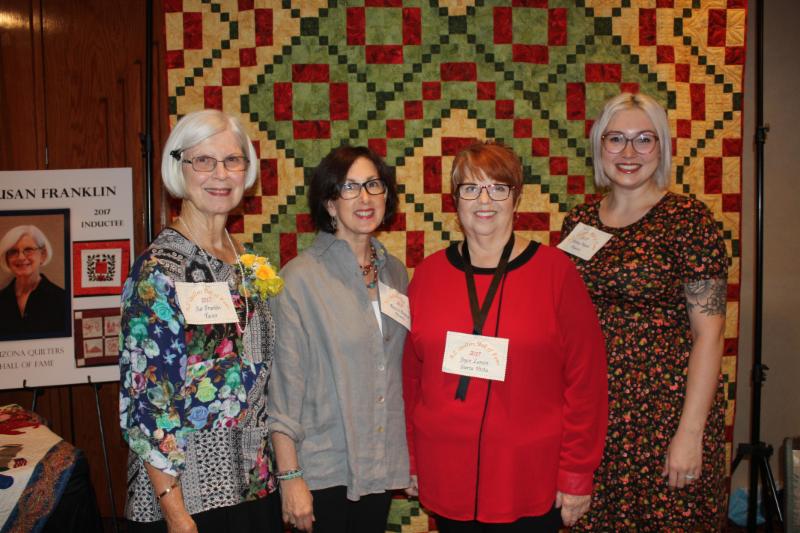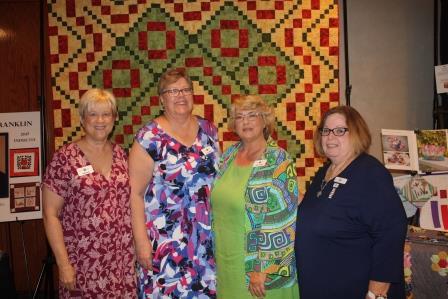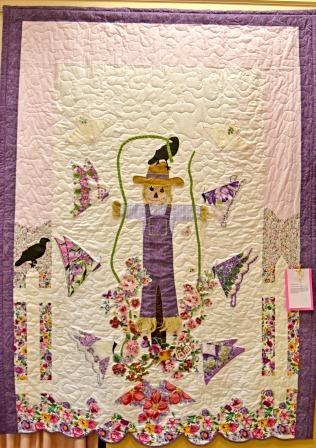President
Treasurer &
Newsletter
Deb Scott
Sierra Vista
Awards Chair
Jan Pederson
Globe
|
|
Our Organizational Friends
|
Arizona Country Register
Hummingbird Stitchers Quilt Guild
Barbara Polston
Rim Country Quilt Roundup
Strawberry Patchers Quilt Guild
Tucson Quilt Guild
|
|
|
|
|
Special Note: We plan to publish our newsletter 4 times each year. Look for Winter, Spring, Summer, and Fall editions!
Please help us expand our readership by sharing with your quilting friends. Just click "Forward e-mail" at the bottom of the page!
|
|

Hello Friends of the Hall of Fame!
What an exciting time for the Arizona Quilters Hall of Fame! We are entering our second decade and working on a new future for our organization as it grows!
We kicked off with a wonderful induction luncheon in late September, honoring quilt-makers representing the traditional and the innovative trends in the art. Congratulations to the Arizona Quilters Hall of Fame Class of 2017:
 Susan Franklin Bonnie Bobman Joyce Larson Danny Heyen Susan Franklin Bonnie Bobman Joyce Larson Danny Heyen
It was wonderful to see so many new faces and to greet old friends and supporters of the AZQHOF. We were particularly delighted that so many of our organization's founders were able to join us!
The luncheon room was lined by winners of the Hall of Fame Award from quilt shows throughout Arizona this past year. Look for their pictures in this issue. It was a truly stunning display, coordinated by our Award Program Chair, Jan Pederson. Look for the new winners this year at your local show --- it might be you!
We also saw a sampling of the many quilts being made for children in foster care.

The Hummingbird Stitch
ers Q
uilt Guild (Sierra Vista), The Foothills Quilters (Glendale), and The Copper Country Quilters (Globe) joined our 10th Anniversary "Celebrate and Serve" project to benefit children i
n crisis.
Over 250 quilts will be distributed through the Court Appointed Special Advocate (CASA) Councils in Cochise, Maricopa, and Gila Counties. This is a program we've just begun and will be extending it through guild groups and shops in the state as the months progress. For details, please contact our Board member, Deb Scott.
The AZQHOF website and Facebook pages will be going through major overhauls in the next few months to make them more informative for you. All suggestions are very welcome and if you feel you would like to be a part of the journey, please contact me to join our Administrative Board. We meet through phone conference and occasional face-to-face meetings - and we have a great time!
Keep Calm and Quilt On! Mary
|
|
|
|
|
Special Thanks to these AZ Quilt Shops for sponsoring our
2017 Induction Event Door Prizes
Cactus Quilt Shop, Tucson
The Copper Needle, Payson
Quilter's Haven, Eagar
3 Dudes Quilting, Phoenix
Bernina Connection, Phoenix
Pinetop Star, Lakeside
The Squirrel's Nest, Sierra Vista
The Quilter's Market, Tucson
Eagle's Wings Quilting, Tucson
Modern Quilting, Phoenix
Quilter's Store Sedona, Sedona
Quilter's Quarters and Bernina, Too, Cottonwood
Connie's Quilter's Hide-A-Way, Kingman
Bolts & More, Gilbert
A Quilter's Oasis, Mesa
Julie's Quilt Shop, Globe
|
|
|
Scenes From the 2017 AZQHOF Induction
|
AZQHOF 2017 Board
and the 2017 Opportunity Quilt 
Deb Scott, Jan Pederson, Mary Lucille, Jan Hackett
And the Winner of our Opportunity Quilt Is: Kay Radcliff from The Copper Country Quilters in Globe!

Kay Ratcliff (r), with our quilt designer and AZQHOF Inductee, Jean Biddick
|
|
|
Featured Quilters- More 2017 AZQHOF Award Winners
|

"Spring Garden" by Shirlee Smith, Thumb Butte Quilters
 "A Hankie Garden" by Janet Bendixen, quilted by Jan Graham
"A Hankie Garden" by Janet Bendixen, quilted by Jan Graham
Piece Makers Quilt Club, Tucson
"Stars in the Garden" by Sharon Watier
Happy Trails Quilt Show, Surprise
>>>>>><<<<<<<<
"Cheryl's Star" by Bonnie Tarlton, quilted by Cheryl Voirin
Material Girls Quilt Show, Winslow
>>>>>>>>>>>>>>>>
"Latte" by Gwen Ashcroft, Round Valley Fiber Arts Show, Eagar
>>>>>>>>>>>>>>>
"Desert Sampler" by Karen Fox, Gila County Fair, Globe
>>>>>>>>>>>>>>>>
"Baltimore Halloween" by Fleda Gorbea, quilted by Pat Roche
Rim Country Quilt Roundup, Gilbert
|
|
History Corner
by Lenna deMarco
|
"A Passion for Purple"
By Lenna DeMarco
There are many ways to determine when a quilt was made and color can often be a useful tool. Over-dyed greens and turkey reds are strong indicators of a mid-19th century quilt. Nile green is most definitely an indicator of the 1920-30s. Purples also changed with the decades and centuries. Creating a fast and vibrant purple from natural dyes is difficult. Early processes involved the overdye of red and blue. Protein fibers like wool and silk produced a stronger color than cellulose - cotton and linen. However, the purple was not a vibrant one, more of a dull lavender and not very fast. With exposure to light and washings, it quickly faded to brown or pink. Looking at early, pre 1850 quilts we often find quite a bit of brown print fabric. While brown was a popular color in the first half of the 19th century, purple was also a favorite. Often what we assume is a brown print is really a faded, natural dye purple. Sunlight and washing have had their way. It's not always easy to determine if a brown fabric was formerly purple. Even fabric buried in the seams can lose its color. Sometimes we just have to guess as to what was the original color.

The first synthetic organic chemical dye was purple and was created quite by accident in 1856. A brilliant mauveine in color, this aniline dye is sometimes referred to as "Perkin Purple", named after William Henry Perkin. A chemist, Perkin was attempting to synthesize quinine and serendipitously created a bright, stable synthetic purple. It became one of the first synthetic dyes to be mass produced. For the 19th century quilt maker, this was quite a break through and widened her color palette.
 Perkin's Mauve:
A letter from Perkin's son with a sample of dyed silk
(from a Wikipedia post by Henry Rzepa)
By the 20th century synthetic dyes were producing a variety of color fast purples including shades of lavender, lilac and raspberry but it's not until 1925 that the pastel palette really takes off. The cheerful quilts of the 1920s and '30s adored lavender and often teamed it with other Easter egg colors like pink, yellow and mint greens. In the 1940s, purples tended toward deeper tones, including burgundy. By the 1950s the lively, lighter purples had reappeared. The last half of the 20th century provided quilters with an astounding range of colors and prints. While each decade generally has its favorite color scheme (think avocado, harvest gold and rust of the 1970s!!), a rainbow of colors is always available. Thanks to young girls who insist on swathing themselves and their rooms in pinks and purples, Mr. Perkin's discovery has proved it is definitely a color here to stay!
|
|
Ask Luce Bobbins! and
Quilt Documentation Program updates will return
in our January 2018 edition
|
|
We wish all quilters a Happy Year End
and we'll meet you again online in 2018!
|
|
|